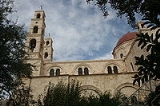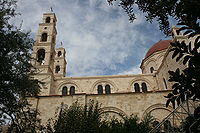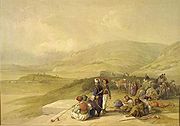
Jacob's Well
Encyclopedia

Jacob
Jacob "heel" or "leg-puller"), also later known as Israel , as described in the Hebrew Bible, the Talmud, the New Testament and the Qur'an was the third patriarch of the Hebrew people with whom God made a covenant, and ancestor of the tribes of Israel, which were named after his descendants.In the...
for roughly two millennia. It is situated a short distance from the archaeological
Syro-Palestinian archaeology
Syro-Palestinian archaeology is a term used to refer to archaeological research conducted in the southern Levant. Palestinian archaeology is also commonly used in its stead, particularly when the area of inquiry centers on ancient Palestine...
site of Tell Balata, which is thought to be the site of biblical Shechem
Shechem
Shechem was a Canaanite city mentioned in the Amarna letters, and is mentioned in the Hebrew Bible as an Israelite city of the tribe of Manasseh and the first capital of the Kingdom of Israel...
.
Also commonly known as Bir Ya'qub or Bir Ya'kub , the well currently lies within the complex of an Eastern Orthodox monastery
Monastery
Monastery denotes the building, or complex of buildings, that houses a room reserved for prayer as well as the domestic quarters and workplace of monastics, whether monks or nuns, and whether living in community or alone .Monasteries may vary greatly in size – a small dwelling accommodating only...
of the same name, in the Palestinian
Palestinian people
The Palestinian people, also referred to as Palestinians or Palestinian Arabs , are an Arabic-speaking people with origins in Palestine. Despite various wars and exoduses, roughly one third of the world's Palestinian population continues to reside in the area encompassing the West Bank, the Gaza...
city of Nablus
Nablus
Nablus is a Palestinian city in the northern West Bank, approximately north of Jerusalem, with a population of 126,132. Located in a strategic position between Mount Ebal and Mount Gerizim, it is the capital of the Nablus Governorate and a Palestinian commercial and cultural center.Founded by the...
in the West Bank
West Bank
The West Bank ) of the Jordan River is the landlocked geographical eastern part of the Palestinian territories located in Western Asia. To the west, north, and south, the West Bank shares borders with the state of Israel. To the east, across the Jordan River, lies the Hashemite Kingdom of Jordan...
.
Religious significance

Judaism
Judaism ) is the "religion, philosophy, and way of life" of the Jewish people...
, Samaritan
Samaritan
The Samaritans are an ethnoreligious group of the Levant. Religiously, they are the adherents to Samaritanism, an Abrahamic religion closely related to Judaism...
, Christian
Christian
A Christian is a person who adheres to Christianity, an Abrahamic, monotheistic religion based on the life and teachings of Jesus of Nazareth as recorded in the Canonical gospels and the letters of the New Testament...
, and Muslim
Islam
Islam . The most common are and . : Arabic pronunciation varies regionally. The first vowel ranges from ~~. The second vowel ranges from ~~~...
traditions all associate the well with Jacob
Jacob
Jacob "heel" or "leg-puller"), also later known as Israel , as described in the Hebrew Bible, the Talmud, the New Testament and the Qur'an was the third patriarch of the Hebrew people with whom God made a covenant, and ancestor of the tribes of Israel, which were named after his descendants.In the...
. The well is not specifically mentioned in the Old Testament
Old Testament
The Old Testament, of which Christians hold different views, is a Christian term for the religious writings of ancient Israel held sacred and inspired by Christians which overlaps with the 24-book canon of the Masoretic Text of Judaism...
; the Book of Genesis (33:18f) states that when Jacob returned to Shechem from Paddan-aram, he camped "before" the city and bought the land on which he pitched his tent. Biblical scholars contend that plot of land is the same one upon which Jacob's Well was constructed.
Jacob's Well does appear by name in the New Testament
New Testament
The New Testament is the second major division of the Christian biblical canon, the first such division being the much longer Old Testament....
's Book of John (4:5f), where it is recorded that Jesus
Jesus
Jesus of Nazareth , commonly referred to as Jesus Christ or simply as Jesus or Christ, is the central figure of Christianity...
"came to a city of Samaria
Samaria
Samaria, or the Shomron is a term used for a mountainous region roughly corresponding to the northern part of the West Bank.- Etymology :...
, called Sychar
Shechem
Shechem was a Canaanite city mentioned in the Amarna letters, and is mentioned in the Hebrew Bible as an Israelite city of the tribe of Manasseh and the first capital of the Kingdom of Israel...
, near the field which Jacob gave to his son Joseph
Joseph (Hebrew Bible)
Joseph is an important character in the Hebrew bible, where he connects the story of Abraham, Isaac and Jacob in Canaan to the subsequent story of the liberation of the Israelites from slavery in Egypt....
. Jacob's well was there." The Book of John goes on to describe a conversation between Jesus and a Samaritan woman
Samaritan Woman at the Well
The Samaritan woman at the well is an episode in the life of Jesus that appears only in the Gospel of John, in . In Eastern Orthodox Church tradition, she is known as Photina.According to the John 4:...
(called Photina in Orthodox tradition), that took place while Jesus was resting at the well.
History
The writings of pilgrimPilgrim
A pilgrim is a traveler who is on a journey to a holy place. Typically, this is a physical journeying to some place of special significance to the adherent of a particular religious belief system...
s indicate that Jacob's Well has been situated within different churches built at the same site over time. By the 330s AD, the site had been identified as the place where Jesus held his conversation with the Samaritan woman, and was probably being used for Christian baptism
Baptism
In Christianity, baptism is for the majority the rite of admission , almost invariably with the use of water, into the Christian Church generally and also membership of a particular church tradition...
s. By AD 384, a cruciform
Cruciform
Cruciform means having the shape of a cross or Christian cross.- Cruciform architectural plan :This is a common description of Christian churches. In Early Christian, Byzantine and other Eastern Orthodox forms of church architecture this is more likely to mean a tetraconch plan, a Greek cross,...
church was built over the site, and is mentioned in the 4th century writings of Saint Jerome
Saint Jerome
Saint Jerome is a Christian church father, best known for translating the Bible into Latin.Saint Jerome may also refer to:*Jerome of Pavia , Bishop of Pavia...
. This church was most likely destroyed during the Samaritan revolts of 484 or 529. Subsequently rebuilt by Justinian
Justinian I
Justinian I ; , ; 483– 13 or 14 November 565), commonly known as Justinian the Great, was Byzantine Emperor from 527 to 565. During his reign, Justinian sought to revive the Empire's greatness and reconquer the lost western half of the classical Roman Empire.One of the most important figures of...
, this second Byzantine
Byzantine Empire
The Byzantine Empire was the Eastern Roman Empire during the periods of Late Antiquity and the Middle Ages, centred on the capital of Constantinople. Known simply as the Roman Empire or Romania to its inhabitants and neighbours, the Empire was the direct continuation of the Ancient Roman State...
era church was still standing in the 720s, and possibly into the early 9th century.

Crusades
The Crusades were a series of religious wars, blessed by the Pope and the Catholic Church with the main goal of restoring Christian access to the holy places in and near Jerusalem...
occupied Nablus in August 1099; early 12th century accounts by pilgrims to the site speak of the well without mentioning a church. There are later 12th century accounts of a newly built church at Jacob's Well. The first such definitive account comes from Theoderic, who writes: "The well ... is a half a mile distant from the city [Nablus]: it lies in front of the altar
Altar
An altar is any structure upon which offerings such as sacrifices are made for religious purposes. Altars are usually found at shrines, and they can be located in temples, churches and other places of worship...
in the church built over it, in which nun
Nun
A nun is a woman who has taken vows committing her to live a spiritual life. She may be an ascetic who voluntarily chooses to leave mainstream society and live her life in prayer and contemplation in a monastery or convent...
s devote themselves to the service of God
God
God is the English name given to a singular being in theistic and deistic religions who is either the sole deity in monotheism, or a single deity in polytheism....
. This well is called the Fountain of Jacob." This Crusader era church was constructed in 1175, likely due to the support of Queen Melisande
Melisende of Jerusalem
Melisende was Queen of Jerusalem from 1131 to 1153, and regent for her son between 1153 and 1161 while he was on campaign. She was the eldest daughter of King Baldwin II of Jerusalem, and the Armenian princess Morphia of Melitene. She was named after her paternal grandmother, Melisende of...
, who was exiled to Nablus in 1152 where she lived until her death in 1161. This church appears to have been destroyed following Saladin
Saladin
Ṣalāḥ ad-Dīn Yūsuf ibn Ayyūb , better known in the Western world as Saladin, was an Arabized Kurdish Muslim, who became the first Sultan of Egypt and Syria, and founded the Ayyubid dynasty. He led Muslim and Arab opposition to the Franks and other European Crusaders in the Levant...
's victory over the Crusaders in the Battle of Hittin in 1187.
In March 1697, when Henry Maundrell
Henry Maundrell
Henry Maundrell was an academic at Oxford University and later a Church of England clergyman who served from 20 December 1695 as chaplain to the Levant Company in Syria. His Journey from Aleppo to Jerusalem at Easter A.D...
visited Jacob's Well, the depth of the water in the well measured 15 feet (4.6 m). Edward Robinson
Edward Robinson (scholar)
Edward Robinson was an American biblical scholar, known as the “Father of Biblical Geography.” He has been referred to as the “founder of modern Palestinology.” -Biography:...
visited the site in the mid-19th century, describing the "remains of the ancient church," lying just above the well to the southwest as a "shapeless mass of ruins, among which are seen fragments of gray, granite columns, still retaining their ancient polish." Local Christians continued to venerate the site even when it was without a church. In 1860, the site was obtained by the Greek Orthodox Patriarchate and a new church, consecrated to St. Photina the Samaritan, was constructed shortly thereafter; a 1927 earthquake in Palestine
Palestine
Palestine is a conventional name, among others, used to describe the geographic region between the Mediterranean Sea and the Jordan River, and various adjoining lands....
destroyed that building.

Zionism
Zionism is a Jewish political movement that, in its broadest sense, has supported the self-determination of the Jewish people in a sovereign Jewish national homeland. Since the establishment of the State of Israel, the Zionist movement continues primarily to advocate on behalf of the Jewish state...
group came to the monastery claiming it as a Jewish holy place and demanding that all religious iconography be removed, the custodian of the well, Archimandrite
Archimandrite
The title Archimandrite , primarily used in the Eastern Orthodox and the Eastern Catholic churches, originally referred to a superior abbot whom a bishop appointed to supervise...
Philoumenos, was found hatcheted to death inside the crypt housing the well. No one was ever arrested for the murder.
Abuna (meaning "Father") Justinus, a well-respected Greek Orthodox priest in Nablus, later spearheaded a huge reconstruction project. Jacob's Well has since been restored and a new church modelled along the designs of the Crusader era church, houses the well inside of it, in a crypt on a lower level.
Physical description and location

Crypt
In architecture, a crypt is a stone chamber or vault beneath the floor of a burial vault possibly containing sarcophagi, coffins or relics....
where the well still stands, along with "a small winch, a bucket, ex-voto icons and lots of lit candles." Joseph's Tomb
Joseph's Tomb
Joseph's Tomb is a funerary monument located at the eastern entrance to the valley that separates Mounts Gerizim and Ebal, 325 yards northwest of Jacob's Well, on the outskirts of the West Bank city of Nablus, near Tell Balāṭa, the site of biblical Shechem...
, a related site, is located just north of Jacob's Well in an Ottoman era
Ottoman Empire
The Ottoman EmpireIt was usually referred to as the "Ottoman Empire", the "Turkish Empire", the "Ottoman Caliphate" or more commonly "Turkey" by its contemporaries...
building marked by a white dome.
According to Major Anderson, who visited the site in 1866, the well has
"a narrow opening, just wide enough to allow the body of a man to pass through with arms uplifted, and this narrow neck, which is about 4 ft. long, opens into the well itself, which is cylindrically shaped, and opens about 7 ft. 6 in. in diameter. The well and upper part of the well are built of masonryMasonryMasonry is the building of structures from individual units laid in and bound together by mortar; the term masonry can also refer to the units themselves. The common materials of masonry construction are brick, stone, marble, granite, travertine, limestone; concrete block, glass block, stucco, and...
, and the well appears to have been sunk through a mixture of alluvial soil and limestoneLimestoneLimestone is a sedimentary rock composed largely of the minerals calcite and aragonite, which are different crystal forms of calcium carbonate . Many limestones are composed from skeletal fragments of marine organisms such as coral or foraminifera....
fragments, till a compact bed of mountain limestone was reached, having horizontal strata which could be easily worked; and the interior of the well presents the appearance of having been lined throughout with rough masonry."
Based on a measurement made in 1935, the total depth of the well is 41 metres (134.5 ft).

